Motorcycle Adventure Tours
Motorcycle Adventure Tours Philippines
Inc. will take you on a trip of a lifetime. We travel through some of
the most beautiful places in the Philippines, with tropical forests,
crystal clear diving reefs, caves to explore, rivers, magnificent
mountains, volcanoes and exotic beaches. You will experience the local
culture and hospitality. This will be like no other adventure tour you
will experience.
You will be on tour with an experienced guide of the Philippines and an experienced rider through these regions.
http://www.adventuretoursphilippines.com/
Accommodation
on the tour ranges from some of the best beachside bungalows in the
Philippines, to exotic hotel stays. The tour routes go through very
low risk areas for tourists with enjoyable terrain and roads. The tour
includes a support vehicle ready for any mechanical failure and other
support needs.
You will be on tour with an experienced guide of the Philippines and an experienced rider through these regions.
http://www.adventuretoursphilippines.com/
Volunteer Vacation in the Philippines.
Volunteer in the Philippines. Environmental volunteering. Convert your holidays into a mix of a volunteering, travel and tour programme.
This fantastic induction to Filipino culture gives you the opportunity to enjoy the beautiful landscapes and activities that the exotic Philippines can offer you. At the same time you can give something back and take part in a volunteering programme.
You are able to choose between five voluntary work experiences:
Combine comfort and leisure, travel adventure holidays, great accommodation, and sightseeing while doing something worthwhile and helpful to the Filipino community.
The goal of this project is to offer travel adventures and volunteer programmes to people who are attracted to learning about Filipino culture, whilst contributing their time and skills to worthwhile community services in the Philippines.
Why international volunteers? Foreign volunteers can have a big impact on indigenous communities, creating important cultural connections highly valued by developing communities.
The benefits of sustainable tourism and voluntary projects are of fundamental importance in issues like poverty, environmental awareness and sustainable develop programmes in the Philippines.
Visit the site to learn more
This fantastic induction to Filipino culture gives you the opportunity to enjoy the beautiful landscapes and activities that the exotic Philippines can offer you. At the same time you can give something back and take part in a volunteering programme.
You are able to choose between five voluntary work experiences:
- Environmental Action Awareness
- Children's Outreach
- Medical, Health and Education
- School Teacher
- Child Care and Rehabilitation Centre
Combine comfort and leisure, travel adventure holidays, great accommodation, and sightseeing while doing something worthwhile and helpful to the Filipino community.
The goal of this project is to offer travel adventures and volunteer programmes to people who are attracted to learning about Filipino culture, whilst contributing their time and skills to worthwhile community services in the Philippines.
Why international volunteers? Foreign volunteers can have a big impact on indigenous communities, creating important cultural connections highly valued by developing communities.
The benefits of sustainable tourism and voluntary projects are of fundamental importance in issues like poverty, environmental awareness and sustainable develop programmes in the Philippines.
Visit the site to learn more
3 Week Volunteer and Escape Adventure Philippines
Company : Twin | Work & Volunteer Abroad
Activities : Care Work / Humanitarian / Medical, Health, Medicine / Orphanage / Community Projects / Charity
Countries : Philippines
Location : This placement is based in the city of Metro Manila and also the close cities: provinces of Laguna and Batangas.
Activities : Care Work / Humanitarian / Medical, Health, Medicine / Orphanage / Community Projects / Charity
Countries : Philippines
Location : This placement is based in the city of Metro Manila and also the close cities: provinces of Laguna and Batangas.
Info
Volunteer in Philippines and Adventure Holidays. Volunteer with Orphans, Children, in Medical Health and Environmental Awareness.Volunteer in the Philippines. Environmental volunteering. Convert your holidays into a mix of a volunteering, travel and tour programme.
This fantastic induction to Filipino culture gives you the opportunity to enjoy the beautiful landscapes and activities that the exotic Philippines can offer you. At the same time you can give something back and take part in a volunteering programme.
Read all about it here
Philippine Adventure Sites

| Adventure Racing Airplane Flying (4) Gamefishing (9) Kiteboarding (9) Mountain Hiking (15) Offtrail Driving (2) Sailing (7) Scuba Diving-> (53) Skydiving (2) Surfing-> (8) Ultimate Adventure (8) Ultralight Flying (4) Wakeboarding (5) Whitewater Rafting (8) Windsurfing (4) from website http://www.e-philippines.com.ph/ |
The Exotic Adventure of Philippine Travel
When it comes to Philippine travel, you will notice the second you arrive to the country that things are done a lot different then anywhere else in the world. In order to explain the concept of Philippine travel, you have to turn back the clock to the days of World War II. It is back in this time period that many of what can be seen today as Philippine travel came from.
For starters, one of the most apparent forms of Philippine travel that one would notice immediately is that of what has become known as the Jeepney. The jeepney is the major form of mass transportation in the Philippines operating much like that of a privately owned bus service which follows specific route, but no specific times. These jeepney are just that, they are based on the World War II U.S. Wiley’s Jeep. The front hood, cowl and the better part of the jeepney mimics that of a stretched out limousine style jeep that is open to the elements.
Unfortunately these jeepneys can not fit down every street because some of the streets are narrow. As a result another World War II concept is utilized in Philippine Travel. For the more narrow streets and places that are off the beaten path, the vehicle you turn to is the tricycle. These are motorcycles with large side cars and the ability to seat a lot of people. There are many different variations of the tricycle and much like the jeepneys, the styles used are largely dependant on the area you are in.
But also like the Jeepneys, the tricyclescan not go everywhere and when it comes to getting around a neighborhood you have to turn to the small two-seater tricykads. These are pedal powered bicycles with a side car and depending on where you go, you can see some pretty artistically designed ones.
For large distance, the preferred means of Philippine travel across land is the bus. These buses are usually tightly packed and come with an amazing sound system built in to keep everyone entertained. A ride in a bus in the Philippines is like a going to a mobilized discothèque.
However, the Philippines is a bunch of islands so to go from one island to another, the form of Philippine travel is the boat. You have large passenger ferries which are based on the World War II landing crafts while at the same time you also have the pump boat. The pump boat is a broad term used to describe any small boat powered by and engine, but the most common of these is known as the banka boat. For great travels from Manila to Cebu, a number of liner services are available which use humongous boats complete with cabins and other sleeping arrangements.
Needless to say, getting around the Philippines can be a fun and exciting. With so many interesting Philippine travel types and styles, you will never get enough. Philippine travel is purely Filipino. Read the original posting at http://kakosa.com/philippine-travel.php
Pinoy Christmas Treats
Pinoy Christmas Treats
Christmas has finally rolled into town. Without a doubt, the season is the best reason to eat, drink, and be merry. And seriously—what would Filipino Christmases be without the boxes of sapin-sapin mysteriously appearing in the refrigerator? Or the pillow-soft bibingka and fragrant puto bumbong welcoming you as you stumble out of Simbang Gabi? Hungry yet? Then get on as we go all around the metro for the best kakanin in town.My Top Five Kakanin
Bibingka
First off let’s start with the ubiquitous bibingka. The Christmas staple is now available all year round, but the certainly the best time to have it (meaning eat as many as one can handle) is during the holidays. Something about the chill in the air and the twinkling lights that make the fluffy rice cake taste infinitely better.
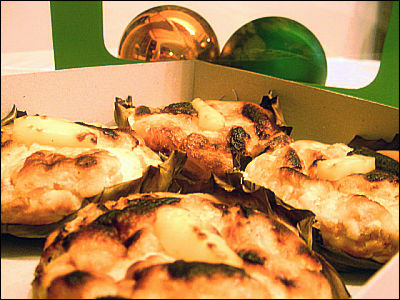
The dish is traditionally made from rice flour, clarified butter, sugar, and egg yolks. This is cooked in a clay oven with the hot coals above. Before it is served, more butter or margarine is spread generously on top, followed by desiccated coconut meat and sugar. If you adore bibingka, one brand to try is the mini-bibingkas of Bibingkabon. The cakes are absolutely heavenly! Owner Pinky Hilado has them prepared with real rice flour and mixes the grated coconut in the batter—making it easier to stuff in your mouth in one go.
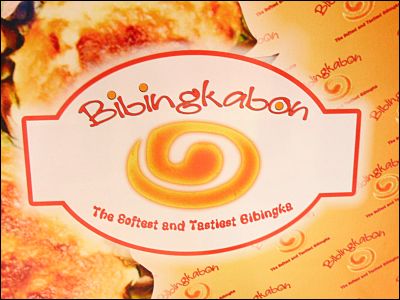
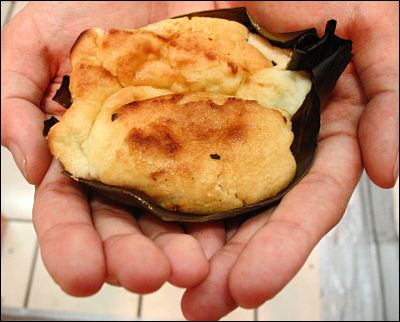
Bibingkabon stalls are found in the following places: Sta. Lucia East Grand Mall, Starmall, and Shopwise Libis. Each bibingka is freshly made -- you’ll rarely find one sitting out because they are snapped up as soon as they come out of the oven!
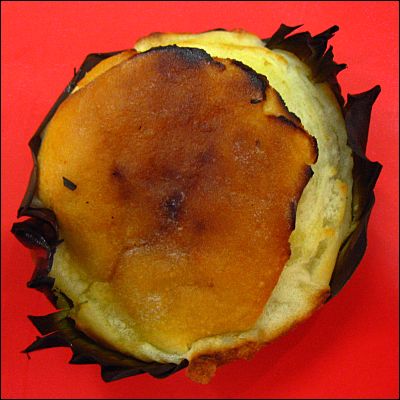
Plain ones go for P15 while Specials—with salty red egg and creamy cheese-- go for P18. If you’re feeling generous in time for the company Christmas party, you can order by bulk two to three days ahead for a minimum of P3,500.
Puto Bumbong
If you find yourself in front of a bibingka stand, chances are, a stall selling puto bumbong is nearby. This curious dessert is made of sticky purple rice, steamed through bamboo tubes, wrapped in banana leaves, and served with a swipe of margarine or butter, grated coconut and sugar.
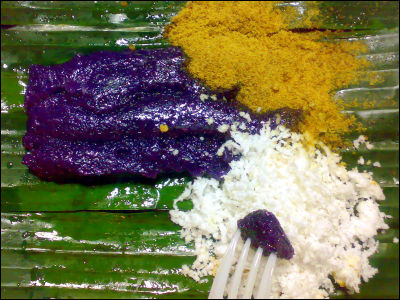
If you should ever get stuck in traffic (and you will be, as Filipino Christmas tradition dictates) along the South Super Highway, pass by the Shell Station right after the Magallanes Town Center. Squeezed in a teeny, tiny corner beside a donut shop, is the aptly named… Shell Magallanes Bibingka Corner. While their bibingka is definitely one of the best in town, try out the freshly made puto bumbong. Their cooks have been there for the longest time and they are quite deft when it comes to preparing these sticky delights.
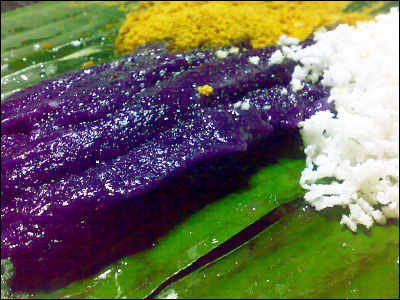
The puto bumbong is gloriously sticky sweet and infused with the scent of the banana leaf wrapper. For P25 a pop, it is cheap means to tide your hunger, or calm things down when the traffic gets awry. Which brings us to our third kakanin: palitaw.
Palitaw
Yes, those palm-sized, milky-white treats are another good reason for stopover.
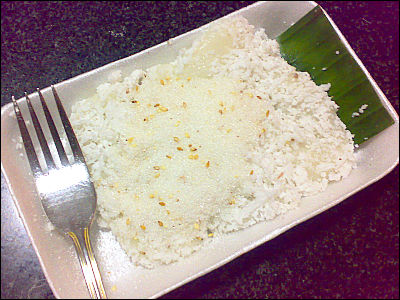
The Bibingka Corner sells them for P20. Request for extra coconut or sugar and they will easily acquiesce.
Sapin-Sapin
Whether they are homesick balikbayans or your Am-boy/-girl cousin spending the holidays with you, nothing spells festive Pinoy dessert more than sapin-sapin.
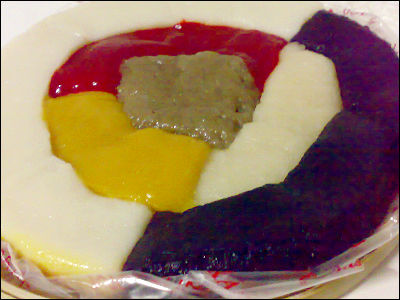
The multi-colored, round-shaped kakanin made with rice flour, coconut milk, sugar, and ube, is a perennial dessert favorite. Dolor’s Kakanin makes one of the best. The main branch is located in Malabon City, and smaller ones in Banawe Ave., Quezon City and Along McArthur Highway in Monumento. The dessert originated from the northern part of the Philippines but has since travelled down to other provinces and is now widely available.
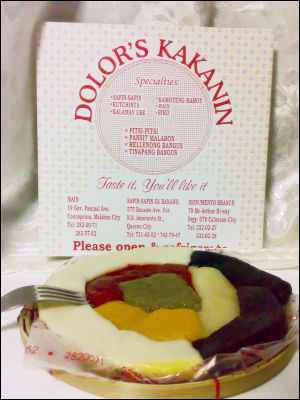
Dolor’s version is absolutely delicious even if, at first glance it seems common looking; one bite of the glutinous dish reveals the densely packed flavor of the sapin-sapin of yore. Each layer is meticulously fleshed out and the ube never overpowers the delicate rice and coconut milk flavors. The large size costs P160 and the smaller one P120.
Suman Latik
For our fifth kakanin, we have the suman latik. Filipinos, used to the heat and humidity of the tropics, will always feel cold enough to wear a jacket during the so-called “brrr” months. The moment a slight bite hits the air, we run and look for the nearest thing to warm our stomachs. The sputtering, gurgling mess that is suman latik is definitely the best thing to warm us up.
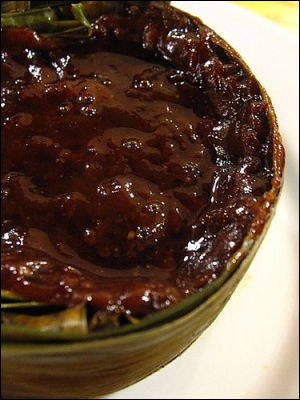
Tsoko.Nut Batirol serves a fine version that will giddy up a good chunk of endorphins in your brain. The dish arrives at your table steaming hot with the thick latik bubbling up. As you dip your spoon into the kakanin, you realize it’s in that fantastic half liquid, half solid state. Eating the dish requires some dexterity, but your efforts are justly rewarded when the mixture hits your tongue and your taste buds go into overdrive. Tsoko.Nut’s version doesn’t scrimp on the latik—even going as far as putting both sugar and rice in equal portions.
The dish is quite rich, and small as it may seem it is best shared with another person. You will have to because you cannot eat suman latik—or any of the abovementioned kakanins for that matter—without a hot cup of traditional tsokolate. Why go anywhere else when Tsoko.Nut serves a fantastic cup of tsokolate ah? Some might recoil at the idea of drinking hot chocolate with sweets (usually bathed in butter at that) but Filipinos usually wave those kinds of worries away. You can never have too much of a good thing, especially during the holidays.
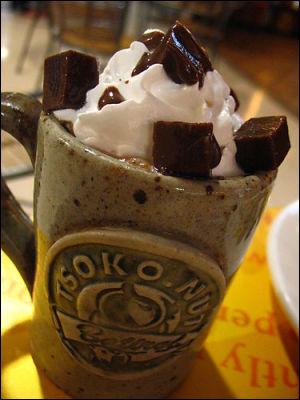
Those with a serious sweet tooth can push the envelope and order Tsokonut Ah with Gulaman, which takes a regular cup of tsokolate ah a step up the indulgence scale by adding buttery whipped cream, gulaman cubes made from tsokolate eh—which is the thick, syrupy hot version of the tsokoloate. To top it off, even more tsokolate eh is drizzled on top of the cream.
Well there you go—Top Five Kakanins to check out during the holiday break. Go on—eat, drink, and be merry. There is no better way to bust your gut during the holidays. Hey, it only comes once a year!
http://www.clickthecity.com/metro/?p=2512
Cemetery Tours of Metro Manila
In the course of my “worldly” tours, nothing has caught my attention more than visits to our very own series of cemeteries in Metro Manila – the Paco Park, a small but romantic cemetery which has gone a full lifecycle; the columbary of San Agustin in Intramuros; The American Cemetery at tony Forbes Park in Makati and the Chinese Cemetery that crosses through the North and La Loma Cemetery in the northeastern part of Manila. Paco park was popularly known as the burial grounds of the wealthy neighborhood of old Manila, has now become a popular venue for garden weddings and receptions.Then there is the columbary of the San Agustin Church where remains of famous Spanish governor generals including Juan Miguel de Legazpi plus a host of others and several other well known Spanish families – Zobels, Ayalas and Sorianos are all neatly buried in one side wall of this church.
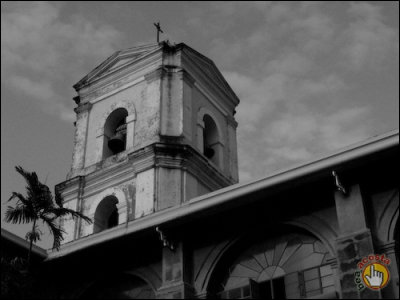
San Agustin Church
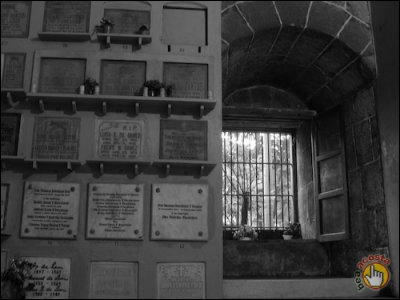
Inside San Agustin Church
But having seen many crypts and mausoleums all over the world, our own burial grounds have hundreds of interesting stories inside them. Majority of these vast manicured properties are so steeped in lore that some of these cemeteries have their own “unofficial historians.”
For instance, the Chinese Cemetery. (Take the LRT Train from Baclaran and get off at the Doroteo Jose station. Take a tricycle and ask to be dropped off at the north gate) It’s a cemetery with star power. Among those buried here are rich Chinese patriarchs and matriarchs. Founded in the 1850s by Lim Ong and Tan Quien Sien, also known by their Christian name, Carlos Palanca, the 54 hectare Chinese cemetery contains graves that tell of wealth and social status of several generations of deceased. Here, one can see mausoleums as high as two stories, resembling temples, pagodas and budhas – everything you can imagine that’s typical Chinese. However, as you examine the area closer, especially the bigger crypts from prominent families, there are living persons maintaining these places complete with electricity, air condition, bathroom facilities even showers to cool off the heat.
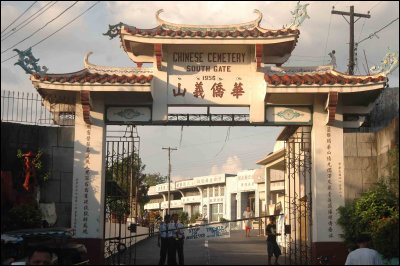
Chinese Cemetery
The state of the Chinese cemetery reflects how the Chinese are in the Philippines. The streets are well paved, and well lit. It seems airier and more spacious somehow commented Teddy, my traveling companion and photographer. If you’re Chinese, you can light your joy sticks at the Chong Hok Tong Temple, where you will find a big golden statue of Budha.
Unfortunately, as one visit this place lately; one notices that the tombs are fast losing their architectural flavor as the cemetery space is getting more and more occupied. Some tombs are in disrepair because of lack of funding or family owners have just left the country.
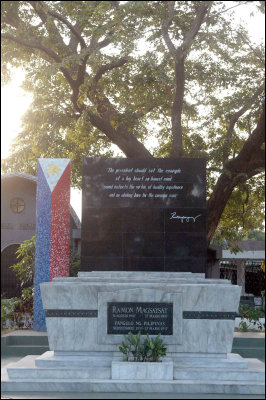
Ramon Magsaysay's Tomb at North Cemetery
Near the Chinese cemetery are the North and La Loma Cemeteries. The North Cemetery is a host to a lot of “who’s who in Philippine history. Three Presidents – Sergio Osmena, Manuel Roxas and Ramon Magsaysay are entombed here. Other politicians buried here include Claro M. Recto, Quintin Paredes, Manila Mayors Arsenio Lacson, Antonio Villegas, Felix Huertas and Manuel de la Fuente. President Gloria Macapagal Arroyo’s mother in law, Lourdes Tuason – Arroyo is buried in the North Cemetery. Two years ago, the remains of First Lady Aurora Aragon-Quezon was exhumed and brought next to her husband’s resting place at the Quezon Memorial Circle in Quezon City. Going around the cemetery, where the raised graves are literally side by side, with very little space from each other, one gets to notice the different busts, figures, and Virgin Mary statues that try to gain this visitor’s attention. I was wise enough to have hired a caretaker guide to bring me around this maze of graves and marbles or I would have been soon overwhelmed by the kaleidoscope before me. No standardize headstones for most of these worthies; instead, equestrian statues, shrouded mausoleums, busts, plaques, overwrought epitaphs, and genuflecting angels are sure enough to win a nod from Saint Peter in heaven.
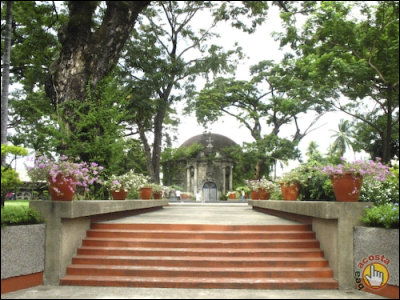
Paco Park
Over at Paco Park, I have always manage to return to this place in between drives from Manila to Makati or Paranaque. I don’t blame some lovers who just want to have their weddings officiated in this “graveyard” turned park. Though quintessentially a Spanish campo santo, Paco Park welcomes tourists and visitors alike. Others bring their children to play tag, or hide and seek. Old ladies and gentlemen arrive here early mornings equipped to feed the hungry colonies of pigeons and maya birds that warble in the cemetery’s grave ruins and acacia trees. Couples too come to hug and kiss; not all are young though, nor is it clear whether all are legally free to hug, but even those whose amours are not necessarily clandestine, find that love blooms along the paths of Paco park. This place is best enjoyed during late afternoons, before closing time (8:30am – 5:00pm) .Paco Park draws one back as I did, having returned often.
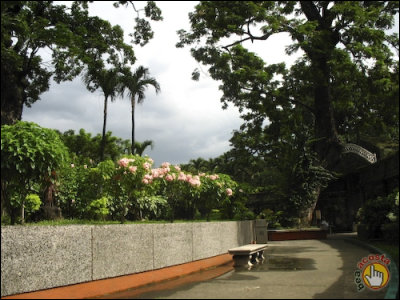
Paco Park
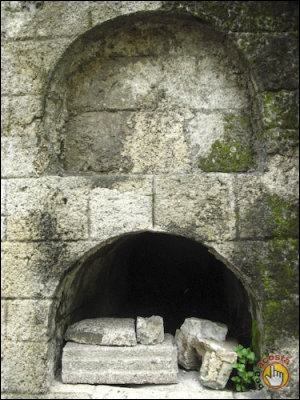
Unmarked and Empty Graves
When I was a child, I was always wondering why there was an American Cemetery in the Philippines when the US, had a far bigger space to bury their dead. As I grew older I realized the American part in our country’s history. The American Cemetery here in the Philippines memorializes the many thousands of Filipinos and Americans who died fighting during the last World War. Apparently, this cemetery is the largest facility outside the United States and consists of hectares of white marble crosses and Stars of David aligned in neat contoured rows up the hillside to the memorial. If you’re on a visit, check out the columns along the walls. You might just have a name posted of your long lost relative who fought in the last world war. As you walk the circular column enjoy one of the best views of the surrounding polo club landscape.

